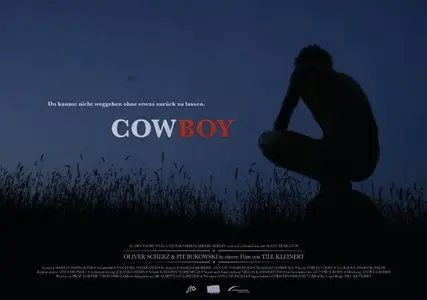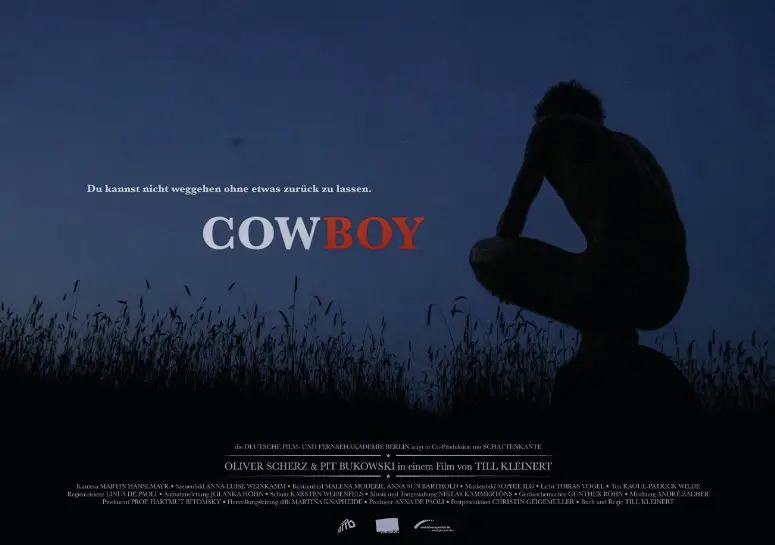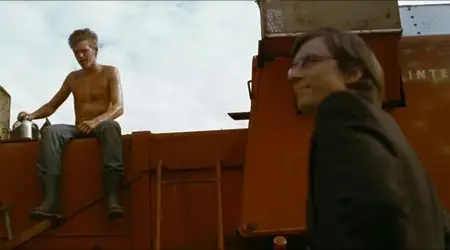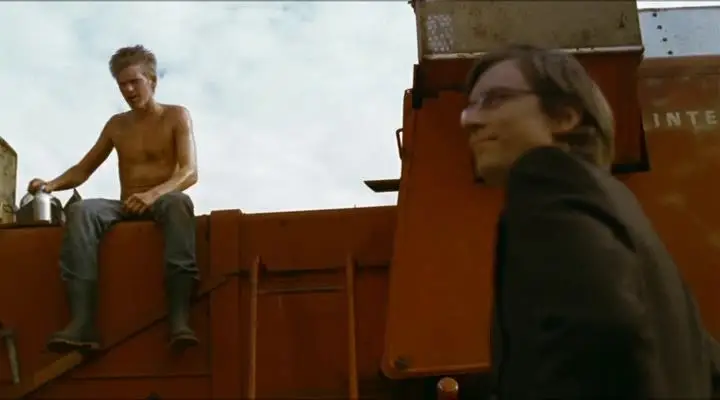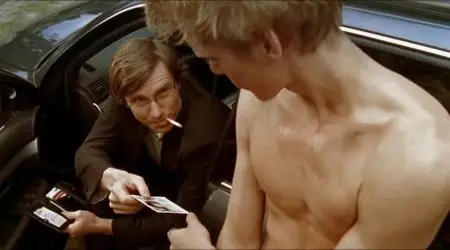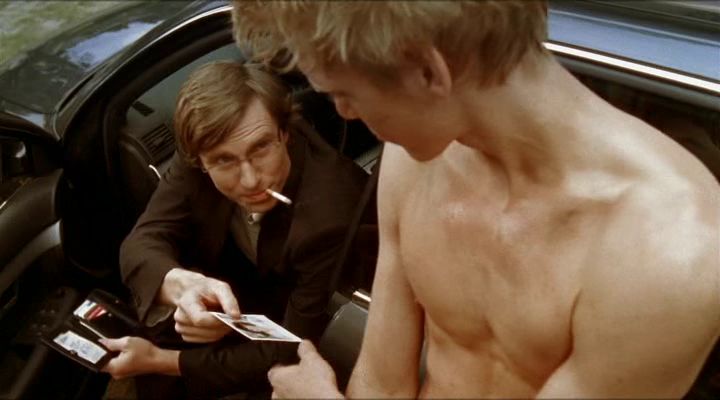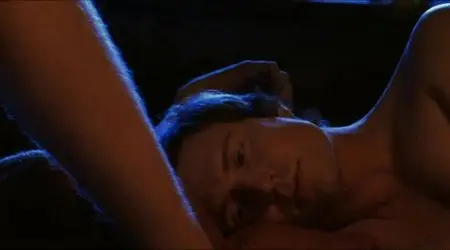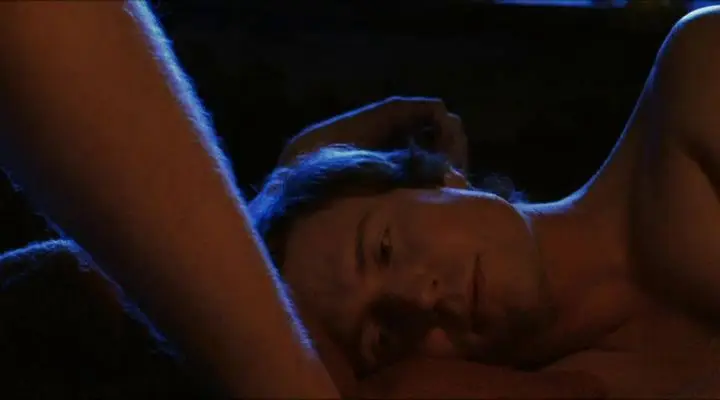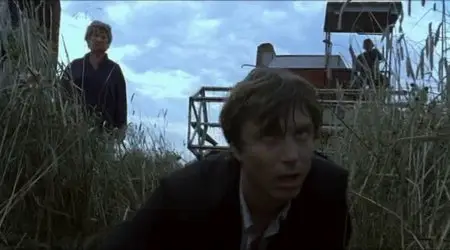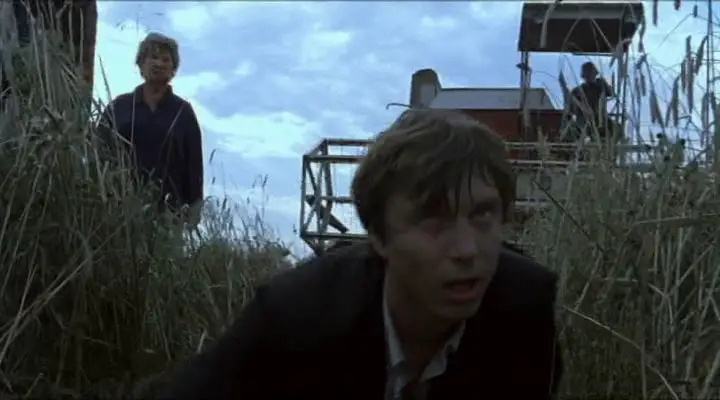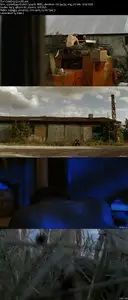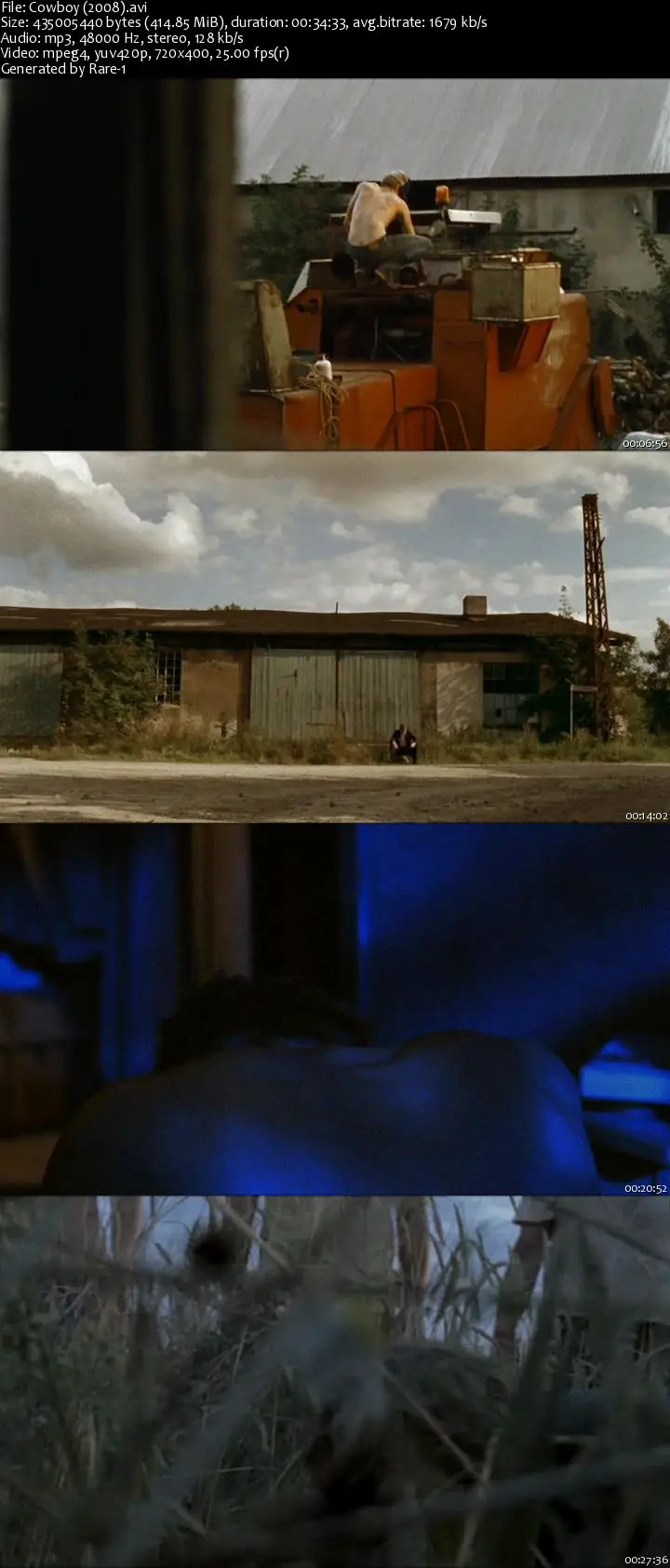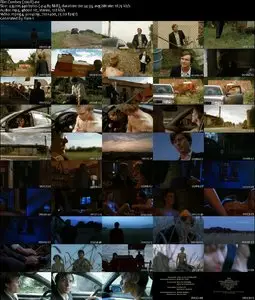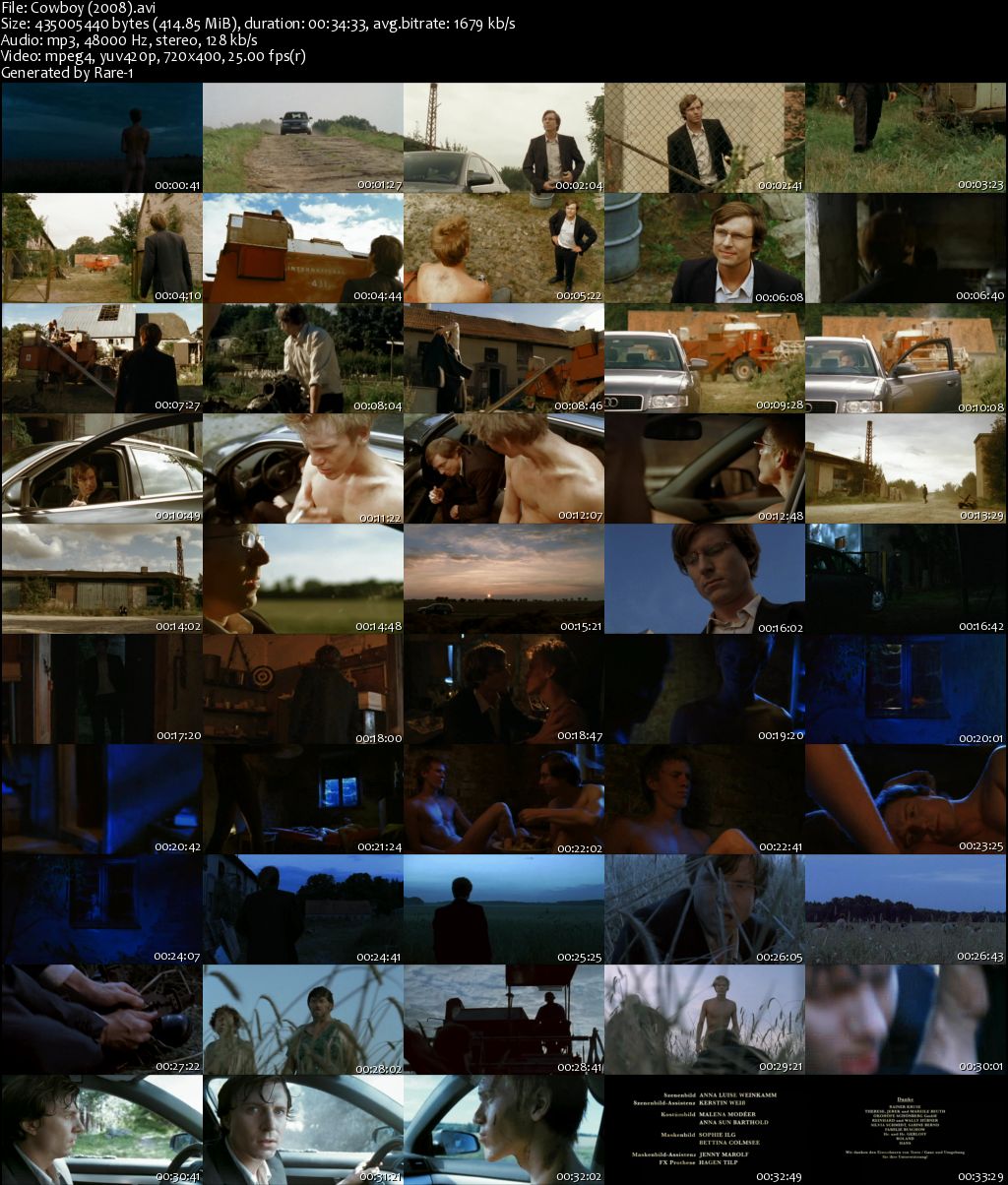Cowboy (2008)
DVDRip | AVI | 720 x 400 | XviD @ 1543 Kbps | 35 min | 415 Mb
Audio: German MP3 2.0 @ 128 Kbps | Subs: English (.srt)
Genre: Short, Horror, Mystery | Germany
DVDRip | AVI | 720 x 400 | XviD @ 1543 Kbps | 35 min | 415 Mb
Audio: German MP3 2.0 @ 128 Kbps | Subs: English (.srt)
Genre: Short, Horror, Mystery | Germany
Real estate agent Christian travels the countryside scouting for investment prospects. In a forgotten, seemingly abandoned village far off the main roads, he finds more than he is looking for. Getting entangled in an encounter with a taciturn teenage farmhand, he confronts his sexual frustrations and, in the process, gets drawn into the undergrowth of a bloodthirsty rustic community.
IMDB 6.9/10 from 212 users
Director: Till Kleinert
Writer: Till Kleinert
Actors: Pit Bukowski, Oliver Scherz
Rated: N/A
Runtime: 35 min
A Decidedly Dark Tale of Love
When an estate agent scouting the German countryside for potential property gains, stumbles upon a rundown farm in the middle of no-where, it isn't long before the click of his camera, mirrors the cash register ringing in his mind. Yet to get the sale, he must first locate the owner, only to become increasingly convinced that an uncommunicative farm hand busy fixing a 'better off in the scrap heap' combine harvester, could well be the last of his line. Only who is this man of mystery and is he really the last one standing?
Cowboy by Till Kleinert Shot in 16mm but blown up to 35mm to striking effect, here writer and director Till Kleinert has created a hauntingly sinister tale, one that lures you into its story, just as city boy Christian found himself lured into spending a night with the farm cowboy of the piece, only to end up getting more than he bargained for. For this is a teen who one minute boasts of having slept with every women in the town and the next, is only too keen to be on the receiving end of some manly attention.
Yet talk of my people in a seemingly deserted village suggests things are not quite what they appear to be. For here Kleinert dramatically ups the stakes to deliver a terrifying work full of menace and bloody horror, one in which the male nudity on offer never takes precedence over plot, being but an inherent part of the story. No surprise to learn that this superbly staged short was awarded the 2008 Iris Prize, given this is gay cinema with a difference; namely a decidedly dark tale of gay love and the price paid for both personal and sexual freedom. Need more be said?
By Ryan Prout.
For three days in October 2008, Cardiff was host to the Iris Prize, one of the highlights on the international calendar of LGBT film festivals. Bigger, better, and brighter, the 2008 event included UK premieres of Antonio Hen’s Clandestinos (2007), Todd Stephens’s Another Gay Sequel: Gays Gone Wild (2008), Yair Hochner’s Antarctica (2008), Casper Andreas’s Between Love & Goodbye (2008), Julia Von Heinz’s Nothing Else Matters (2007), and James Bolton’s Dream Boy (2008). As in its inaugural year, the festival also included a program of short films, nominated from festivals around the world, and in competition for the £25,000 Iris Prize. Featuring Icelandic wrestlers, Australian cuddle groups, and German cleaning ladies, the titles in competition reflected the shift perceived more generally in gay culture from a diversity based on a putatively uniform difference of sexual orientation to diversity within difference. As jury member and Independent journalist Johann Hari put it, the range of films underscored the shift in gay identity politics from a discourse which claims ‘I am what I am’ to one which insists ‘I am what you are’.
The Friends of Iris chose Dream Boy as the recipient of the new award for the festival’s best feature. Northern Ireland director Conor Clements won the Skillset award for James (2008). Russell T. Davies presented German filmmaker Till Kleinert with the Iris Prize for Cowboy (2008). The winning film explores an impulsive relationship between an enslaved farmhand and a slick property developer, and is set against the backdrop of an abandoned harvest in a forgotten landscape. A metropolitan visitor’s survey of this remote rural investment prospect forces him to confront his sexual frustrations and, in the process, draws him into the undergrowth of a bloodthirsty rustic community. Below the belt meets underbelly as scenes which unleash pent-up sexual tension in a way reminiscent of Clay Farmers (1988), converge with a menacing remoteness, evocative of Straw Dogs (1971) or Funny Games (1997). The same open landscape which liberates the suited executive’s desires turns into a monster pullulating with hidden life and threatening his survival. He escapes, taking with him Cowboy, the rusticated punk whose shackles have also been broken by this seemingly random homosexual encounter. If Hergé were to illustrate M. R. James, the results might look a bit like Cowboy.
Elan Closs Stephens, Professor of Communications and Creative Industries at Aberystwyth University, was the chair of the 2008 international jury. Explaining the panel’s choice of Cowboy as the winning film, she pointed to Kleinert’s deft interlacing of narrative modes, a trend characteristic of LGBT filmmaking’s move towards transgenericism. She singled out Cowboy as a film which showed great potential for the development of a distinctive and innovative cinematic vision. Besides Cowboy, Kleinert has made 12 shorts as well as the feature Lange Nacht (2004).
Ryan Prout asked Till Kleinert about the making of Cowboy and the influences which helped to form the singular aesthetic of a film the director calls an ‘Erotic folk tale’.
RP | Where in Germany was Cowboy shot, and how did you find the location? Does the narrative in any sense grow out of the setting and can we read it as a fable about the co-dependency of the East and the West in the post-reunification era?
TK | The film was shot in a village called Ganz (which, by the way, translates as ‘whole’), in a region of Brandenburg called the Ostprignitz, 100 kilometres north of Berlin. Years ago I spent a weekend in a neighbouring village where a friend’s family had a nicely run down summer house. We walked to Ganz and I was amazed – the place looked almost completely deserted. Many of the houses were abandoned, and there was a big derelict estate, the yard all overgrown and the buildings slowly crumbling. The only people we saw were some teenage boys on their bikes circling the bus stop, giving us suspicious looks. It was like a materialization of the stereotypical image of Germany’s rural east, run wild with the breakdown of collective agriculture.
So yes, you really can’t make a film in that area without having that written in the subtext. It was easy in that context to imagine an agricultural collective left without a purpose after the social upheaval, detaching themselves from the outside world, becoming figuratively invisible, like ghosts. And the combine, having once been the fetish of modern agriculture has now become a more sinister symbol of degeneration. And also real estate agents, hungry for cut-price property investments, were not uncommon, at least in the early years after re-unification. But it was never the main intention to have the film be about the East / West relationship. I merely used that as a backdrop for a story about the desire to break out of collective and societal boundaries, to let your instincts run free, even at the expense of being cast out and punished – in a most physical way.
That said, being an East Berliner myself, the theme of East / West co-dependency seems to be written into my genes, and I think my films can’t help exploring that issue, at least subconsciously. And I’m always happy about people pointing that out to me. Interestingly, so far they have been viewers from outside Germany who have been the most sensitive to that particular theme.
RP | Cowboy is not the average gay short. In terms of genre, what would be the best description of the film, and what were you aiming to do by criss-crossing conventional generic boundaries? How did you want your audience to feel?
TK | Well, first of all I’m only beginning right now to realize what the average gay short might be, with Cowboy going to lots of LGBT film festivals and the opportunity that’s given me to see so many short films. Despite being gay and not having any hang ups about it, I never felt very close either to a gay lifestyle or to gay culture, whatever they might be. I’m a bit suspicious of a community that defines itself through sexual orientation alone. I am aware that there are experiences, like teenage confusion over coming out, or being passed over by a straight guy, which I share with most other gays. But that doesn’t necessarily mean we have much common ground beyond that. For example, I hate the superficiality with which gays are presented by the media, the whole focus on things like partying and fashion and grooming and interior design and all the other Queer Eye for the Straight Guy topics. What does that have to do with being gay? But most media, straight or gay, seem more than happy reproducing that image. I feel left out.
I didn’t set out to make a queer film. In terms of genre labelling, I think of Cowboy as an erotic folk-tale horror film with gay protagonists. But that can be misleading, too, as there is not much obvious horror going on for most of its running time. It is a horror film in disguise, sneaking up on its protagonist and the viewer. Luring him into believing he has it all figured out, giving him the chance to fulfil his hidden needs, only to pull the rug from beneath his feet in the end, confronting him with the price the community—that antagonistic force that has been lurking all the time just outside of our area of perception—has him and the boy pay for following their instincts.
The film is the most fun with an audience which is neither gay nor horror-savvy: they have their initial perception of the characters and the story turned round 180 degrees twice in only thirty minutes. I wanted to achieve a deep sense of liberation, of discovering your true nature, escaping the hands of the community, smashing the boundaries of perception and genre, and then being free to live as you like.
RP | The men’s bodies in Cowboy are branded very literally by the physical and social context. Is the male body in German cinema similarly marked by political history?
TK | Right now I’d say I’d be happy if something like the male body actually existed in contemporary German cinema. German films at the moment don’t seem to be very physical to begin with. I think the literal connection of psychological or societal conflict with an actual physical challenge (for example, in the form of a combine harvester at someone’s heels) is generally deemed too simplistic, too over the top. You won’t find many fights, chases, physical injuries, matters of life and death, or even kissing or sex scenes in contemporary German cinema. The dogma of realistic storytelling forbids that. The repression of certain instincts in the reality of middle-class society must be reflected in an equally repressed storytelling. The chance to use film metaphorically, as a means to express internal conflict physically, isn’t used very often. But there are a few great German films, in which societal and personal pressure result in very physical demonstrations of affection – like Fatih Akin’s Gegen die Wand (2004) or Valeska Grisebach’s Sehnsucht (2006).
RP | Do Cowboy and Christian live happily ever after? Where does that road lead?
TK | It is definitely a happy ending, and a well-deserved one, I’d say. But I’m not quite sure whether it means that those two will stay together in the future. Basically I think they gave each other what they needed to escape from their respective prisons, and now they are free to move wherever the road leads them. It could be the beginning of something, but their whole relationship would have to be reinvented from scratch. They are different men now, and maybe they don’t need each other that much any more. I think the point I was trying to make was that it took one hell of a struggle and a brutally violent act of liberation for them to be able to sit together in the car at the end. And because they fought so hard, with each other, within themselves, with the community, it is a very precious moment.
There is some mischievous irony at the end as well. Although Christian, just like the audience, will need some time to let events sink in —to make up his mind about the horrible string of events and the boy/monster sitting next to him—’Dreckiger Junger Mann’ (‘Dirty Young Man’), the song playing on the radio as they drive away, creates all of a sudden a euphoric, lawless, us-against-the-world-feeling, very unapologetic. The music—an eighties-style wave-rock anthem—goes beyond taste and beyond reason. Yet as a viewer you cannot resist its driving force, and will eventually give up reasoning and embrace the feeling of liberation.
RP | What would you list as your main influences?
TK | The initial inspiration for Cowboy came when I found a deer cut in half in a freshly harvested field. The sound of a combine harvester’s engine in the distance was the clue to what had happened. It was a grey, gloomy day and everything felt subdued and still, as if packaged in cotton. Asking what story could be behind this sort of image is my starting point. What kind of film does it belong to? As I’m writing the screenplay, I usually find out what that first image is all about, even if it doesn’t actually turn up in the film.
My favourite author is H. P. Lovecraft: remote landscapes, abandoned cities, a strong sense of decay, nightmares, desolation. Something old, sleeping below the surface, or gazing at us out of the cold, empty space above. But whereas in Lovecraft’s work—reactionary xenophobe that he was—the only possible outcome of close contact with those forces from the outside is defeat and madness, I come to more positive conclusions.
I really love Alan Moore’s graphic novel The Swamp Thing. It is a great example of a fantastic parallel world existing within our own, at once horrifying and tempting. In terms of structure, the short stories of Clive Barker have been a huge influence, the way he starts his narrations at a point of safe everyday experience and from there manages to lure you into much more dangerous terrain, introducing the supernatural and horrific elements in such a matter-of-fact way that the reader has to swallow them as part of the reality. In his stories you can’t actually tell at which point reality ends and where dream or nightmare begins. He keeps the boundaries fluid. That’s what I try to achieve in my films as well.
In general I would call Steven Spielberg one of the great influential filmmakers for me, especially Duel (1971), E.T. (1982) and Empire of the Sun (1987). Obviously there is a tendency to dismiss him as manipulative and non-intellectual. But think of him what you will, he is a master of fluid, visual, and visceral storytelling, and generates a rich cinematic experience rather than a mere stream of thoughts and arguments. Then there is the transgressive and liberating cinema of Takashi Miike and Shinya Tsukamot, and David Cronenberg with his unique, very physical approach to the human body. And, maybe the greatest of them all, Hayao Miyazaki with his joyful sense of adventure and wonder and general good-natured humanism. But the list could go on forever.
RP | Can we see a progression from your earlier work to Cowboy? Is there a kind of nocturnal aesthetic in your films?
TK | There does seem to be a kind of gravitational force that tends to pull me towards dark and grim matters and settings. I guess I’m just wired that way. Developing my basic ideas into stories, they mostly tend to become mystery or adventure stories, with the hero (mostly male, don’t ask me why) entering a world or milieu strange and mysterious to him, encountering something much more dangerous, deep and dark than he is prepared for, often pushing the boundaries of reality towards the fantastic. In the end, he returns to the real world, painfully bruised and transformed by the experience. But mostly transformed for the better – liberated, or more mature, like in Xerox/UV, The Ballad of Two Shoes, Hundefutter, or Cowboy. Or the transformation is so complete that he never returns to where he came from and stays in the other world, as in Intruder, Draussen, Tape Rage and Lange Nacht.
In my films the unknown, that which is hidden in the dark or in places far off the map, is at once frightening and intriguing. It offers the hero a source of a profound self-realization he would never have experienced in a safe environment. At the end of Lange Nacht there’s a song called ‘In der Finsternis’ by Virginia Jetzt which includes a line that roughly translates as: ‘In the darkness everything becomes much clearer’. Nicely put, I think. So, for me as a filmmaker, the night, the darkness, the realm of the fantastic and the horrific, is a place to face and realize instincts, desires, and needs I might not dare to admit in the broad daylight of purely realistic storytelling: there is a reason why most sexual encounters happen by night. Most murders, too.
I definitely feel a progression from my earlier films to Cowboy. On a technical level I have become much more confident in the use of film language, in finding the right shots to break down the narrative and express a certain mood, creating a slightly heightened, filmic reality without letting the images become an end in themselves. Also, being able to shoot my last two films on 16mm as opposed to video made me realize a whole new dimension of texture and made the visual storytelling much more precise, because you only have a limited amount of reels, and that makes you choose your shots very carefully. And I think I got better with actors, or at least with casting, because I feel that the acting in my films improved a lot during the years.
My recent films are more personal. Now I openly address my own insecurities, fears and longings, and allow them to be the narrative’s driving force. For instance Cowboy is my first film with overtly gay content, and I feel happy to have learned to use film as a means of exploring and expressing something as subjective as sexual desire.
It’s often the case that progression or maturing for an artist is supposed to be a process of letting go of your childish interests and becoming more adult and sober, more realistic and down-to-earth, less playful. I don’t think that’s the case with me. I think the more I progress as a filmmaker, the more I embrace what fascinated me as a child – the fantastic. As a child, I was only able to watch these stories unfold in awe from the outside, not consciously understanding their deeper implications; I have since found a way of going inside them, being able to see more clearly why they mean so much to me and to infuse them with my own personality.
RP | Do you have any plans for how you might use the Iris Prize award? Are there points in common between the UK and the underbelly of Germany you’ve explored in your previous films?
TK | I’m entitled to make another short with that money, and to do it in the UK. I would like to shoot it in Wales, as early as the summer. All the digging for the story still has to be done. I think I’ll return to Cardiff at least once early in 2009 to write the screenplay.
It will be my first film shot outside of Germany, and I’m very anxious to live up to the opportunity this presents. I don’t just want to make a German film in Wales. I want to shoot in another language, English, or Welsh. I want to find that dark and grim place full of secrets that connects with my sensibilities as well as with the context of the region I’m shooting in. I’m really looking forward to exploring.
Ryan Prout teaches film and writing in the Department of Hispanic Studies, Cardiff University.
More Screenshots:
General
Complete name : F:\Cowboy (2008)\Cowboy (2008).avi
Format : AVI
Format/Info : Audio Video Interleave
File size : 415 MiB
Duration : 34mn 33s
Overall bit rate : 1 678 Kbps
Writing application : VirtualDubMod 1.5.4.1 (build 2178/release)
Writing library : VirtualDubMod build 2178/release
Video
ID : 0
Format : MPEG-4 Visual
Format profile : Advanced Simple@L5
Format settings, BVOP : 1
Format settings, QPel : No
Format settings, GMC : No warppoints
Format settings, Matrix : Default (H.263)
Muxing mode : Packed bitstream
Codec ID : XVID
Codec ID/Hint : XviD
Duration : 34mn 33s
Bit rate : 1 543 Kbps
Width : 720 pixels
Height : 400 pixels
Display aspect ratio : 16:9
Frame rate : 25.000 fps
Color space : YUV
Chroma subsampling : 4:2:0
Bit depth : 8 bits
Scan type : Progressive
Compression mode : Lossy
Bits/(Pixel*Frame) : 0.214
Stream size : 381 MiB (92%)
Writing library : XviD 1.2.1 (UTC 2008-12-04)
Audio
ID : 1
Format : MPEG Audio
Format version : Version 1
Format profile : Layer 3
Mode : Joint stereo
Mode extension : MS Stereo
Codec ID : 55
Codec ID/Hint : MP3
Duration : 34mn 33s
Bit rate mode : Constant
Bit rate : 128 Kbps
Channel(s) : 2 channels
Sampling rate : 48.0 KHz
Compression mode : Lossy
Stream size : 31.6 MiB (8%)
Alignment : Aligned on interleaves
Interleave, duration : 80 ms (2.00 video frames)
Interleave, preload duration : 504 ms
Writing library : LAME3.98r
Encoding settings : -m j -V 4 -q 2 -lowpass 17 -b 128
Language : Deutsch
LabView - Collective Books
Mega E-books Pack (2013)
Malware Centric E-book Collection
Huge Electricity, Magnetism, A..., Healing - EBooks Collection
Premium IT eBooks Collection
Huge Encyclopedias - EBooks Collection
Osprey Publishing - Military History Books Collection
Gale Encyclopedias - Full Pack
IT Books Collection (Basic - Intermediate - Advance)
Medicinal and Aromatic Plants - 50 Volume Set
Doctor Who ebooks Collection
Learning HTML Ultimate Collection
Comprehensive Robotics Books Collection
Great Royal Web Design Pack
Civil Engineering Geotechnical books
Luftwaffe Colours Collection
Many Thanks to Original uploader.
For More Rare Movies Check out my blog!
Download Links :
No Mirrors Please


